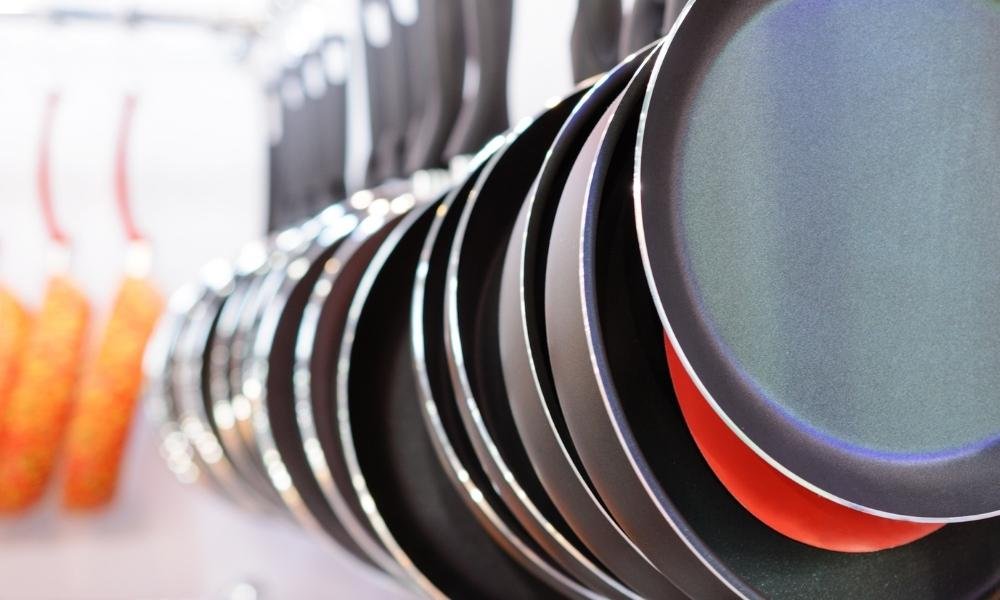Hate it, or love it, there is no denying that nonstick cookware make cooking and the cleanup incredibly easy. Given the safety concerns, many are looking to opt for safer cookware that are healthy and durable. Even so, most households have at least one nonstick pan to quickly make an omelette or fry fish. Given the dilemma of choosing between health and convenience, you can’t but wonder if there are safe nonstick cookware or if there are ways to ensure safety while cooking with nonstick. Let us explore both.
Why Nonstick Cookware Are Considered A Safety Hazard?
The coating you find on nonstick cookware is PTFE ( Polytetrafluoroethylene). Some people call it Teflon coating. But Teflon is a brand that manufactures PTFE. Just like how Xerox became synonymous with photocopying, Teflon has become synonymous with PTFE.
Chemours, the manufacturer who owns the brand Teflon used to have PFOA ( Perfluorooctanoic Acid) in the manufacturing process of PTFE. They are proven to have adverse health effects causing liver diseases, cancer, developmental defects in the foetus during pregnancy and so on. So, in the 2000s, PFOA was banned in the US. Now, Teflon uses other chemicals in the manufacturing process, which are deemed safe.
Though PFOA is banned in the US and EU, they are still very much in use in India. Water taken from around manufacturing hubs have found to contain high levels of PFOA in them.
Most manufacturers claim their cookware to be PFOA-free. But, the BIS safety standards do not regulate it. So, you have to take the manufacturer’s word at face value.
Now, even if the nonstick cookware doesn’t have PFOA, you shouldn’t overheat them as PTFE breaks down when heated to above 260 °C ( 500°F) and releases toxic fumes. They are carcinogenic and may cause polymer fume flu. It is also harmful to birds.
Related reading: Nonstick vs Hard Anodized Cookware
Ceramic vs Granite Cookware
Mitigating Risks of Nonstick Cookware
While nonstick does have some inherent safety risks, you can take a few steps to mitigate the risks.
Quality of Nonstick Coating

First of all, buy from brands that use nonstick coating from the EU. Most cookware brands buy nonstick coating from specialized coating manufacturers. For example, Hawkins claims to use nonstick coating from a German company, while Carote uses coatings from Swiss-based manufacturer ILAG.
EU has banned PFOAs and PFAs ( Polyfluoroalkyl) which are both harmful to our health. So, you can safeguard yourself by using brands that use nonstick coating from manufacturers in the EU.
Teflon is made by Chemours, which is a US-based company. Considering their shady history of using PFOAs and claiming it to be safe for decades, we don’t know what a lawsuit in the future will unveil about their present manufacturing process. Supporters may claim that Teflon is FDA approved. But, this doesn’t necessarily guarantee safety.
It is better to avoid brands that don’t disclose the manufacturers of the nonstick coating they use because they may be locally made and hence unregulated. Moreover, these coating manufacturers are also guilty of contaminating the water bodies near their factories with PFAs and other harmful chemicals.
Related reading: How To Clean Nonstick Tawa?
The thickness of the Nonstick Cookware
One of the key hazards of using nonstick cookware is that overheating can emit harmful fumes. How quickly the nonstick cookware overheats depends to an extent on the thickness of the cookware.
We dry heated pans on medium-high flame and found that a 11-inch pan with 2.5mm thickness touched 260 degrees Celsius in just 1 minute 40 seconds. But a 5 mm thick pan of the same size took 3 minutes. So, you can reduce the possibility of overheating by opting for thicker nonstick cookware.

Carote, for example, has pans with a 5mm thick bottom, while Circulon’s hard-anodized nonstick cookware has 6mm thickness. Bergner uses a Triply stainless steel base in their Hitech Prism range of cookware, which is also thick-bottomed.
Most of the nonstick pans and Kadhai from Hawkins have 3.25 mm thickness, while most of the ones from Wonderchef has 3-3.5 mm thickness. Options from Prestige and Pigeon have 2.8mm and 2.3-3mm thickness respectively.
Nonstick cookware will never be as safe as a traditional clay pot or cast iron cookware. But, by buying the right product and with careful handling, you can mitigate its risks and enjoys its convenience.
